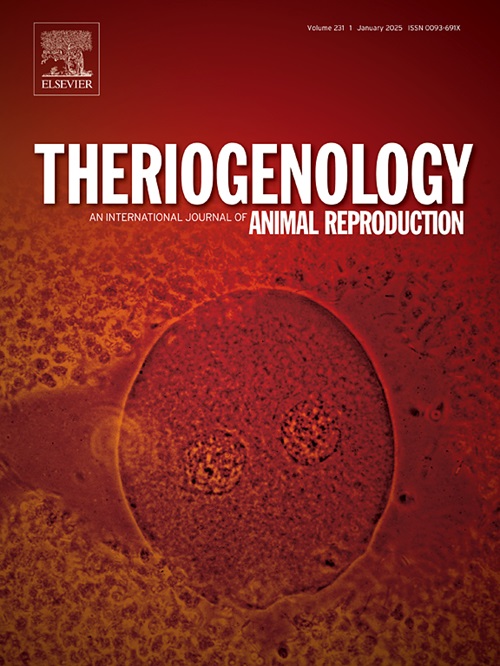速尿钠通过抑制NKCC1提高AQP3的表达,从而提高小鼠和牛囊胚的玻璃化冷冻率
IF 2.4
2区 农林科学
Q3 REPRODUCTIVE BIOLOGY
引用次数: 0
摘要
速尿钠是一种抑制Na-K-2Cl共转运蛋白(NKCC1)的环状利尿剂,常用于水肿的临床治疗。在这项研究中,我们研究了速尿钠是否可以通过促进囊胚腔液的排出,从而提高冷冻保护剂的渗透和减少冰晶的形成,从而提高玻璃化小鼠和牛囊胚的存活率和质量。用加或不加速尿钠的平衡液(ES)和玻璃化液(VS)对小鼠和牛囊胚进行玻璃化,然后解冻,进行存活和质量评估。结果表明,速尿钠可显著提高解冻后存活率(P <;0.05)。它还显著降低了活性氧(ROS)水平(P <;0.05)。此外,速尿钠增加谷胱甘肽(GSH)水平(P <;0.05),线粒体功能增强。线粒体功能的改善反映在线粒体膜电位的增加上,这是线粒体健康和能量状态的关键指标(P <;0.05)。免疫荧光分析显示,速尿钠下调NKCC1蛋白水平,上调水通道蛋白3 (AQP3)蛋白水平(P <;0.05),说明速尿钠调节离子转运和水分调节。这种调节可能有助于关闭钠钾离子通道,减少离子流入并促进囊胚的水流出。这种封闭限制了细胞外钠和钾的流入,显著减少了囊胚腔内的这些离子(P <;0.05)。在小鼠和牛囊胚中观察到类似的效果,速尿钠促进囊胚腔排出液体,从而提高玻璃化效率。这些发现表明,速尿钠可能是一种很有希望的通过增加囊胚腔渗透压差来提高囊胚玻璃化效率的药物。本文章由计算机程序翻译,如有差异,请以英文原文为准。
Furosemide sodium enhanced AQP3 expression by inhibiting NKCC1 leading to improved vitrification freezing rates of mouse and bovine blastocysts
Furosemide sodium, a loop diuretic that inhibits the Na-K-2Cl cotransporter (NKCC1), is commonly used in clinical treatment of edema. In this study, we investigated whether furosemide sodium could improve the survival and quality of vitrified mouse and bovine blastocysts by promoting the expulsion of blastocoelic fluid, thus enhancing cryoprotectant penetration and reducing ice crystal formation. Mouse and bovine blastocysts were vitrified using equilibration solutions (ES) and vitrification solutions (VS) with or without furosemide sodium, then thawed for survival and quality assessment. Results indicated that furosemide sodium significantly improved post-thaw survival rates (P < 0.05). It also markedly reduced reactive oxygen species (ROS) levels (P < 0.05). Additionally, furosemide sodium increased glutathione (GSH) levels (P < 0.05) and enhanced mitochondrial function. The improvement in mitochondrial function was reflected in increased mitochondrial membrane potential, which are key indicators of mitochondrial health and energy status (P < 0.05). Immunofluorescence analysis revealed that furosemide sodium downregulated NKCC1 protein levels and upregulated Aquaporin 3 (AQP3) protein levels (P < 0.05), indicating that furosemide sodium modulates ion transport and water regulation. This modulation likely contributes to the closure of sodium-potassium ion channels, reducing ion influx and promoting water efflux from the blastocyst. This closure limited extracellular sodium and potassium influx, significantly reducing these ions within the blastocyst cavity (P < 0.05). Similar effects were observed in both mouse and bovine blastocysts, where furosemide sodium promoted fluid expulsion from the blastocoel, thereby enhancing vitrification efficiency. These findings suggested that furosemide sodium may be a promising agent to improve vitrification efficiency in blastocysts by increasing osmotic pressure differences across the blastocoel.
求助全文
通过发布文献求助,成功后即可免费获取论文全文。
去求助
来源期刊

Theriogenology
农林科学-生殖生物学
CiteScore
5.50
自引率
14.30%
发文量
387
审稿时长
72 days
期刊介绍:
Theriogenology provides an international forum for researchers, clinicians, and industry professionals in animal reproductive biology. This acclaimed journal publishes articles on a wide range of topics in reproductive and developmental biology, of domestic mammal, avian, and aquatic species as well as wild species which are the object of veterinary care in research or conservation programs.
 求助内容:
求助内容: 应助结果提醒方式:
应助结果提醒方式:


